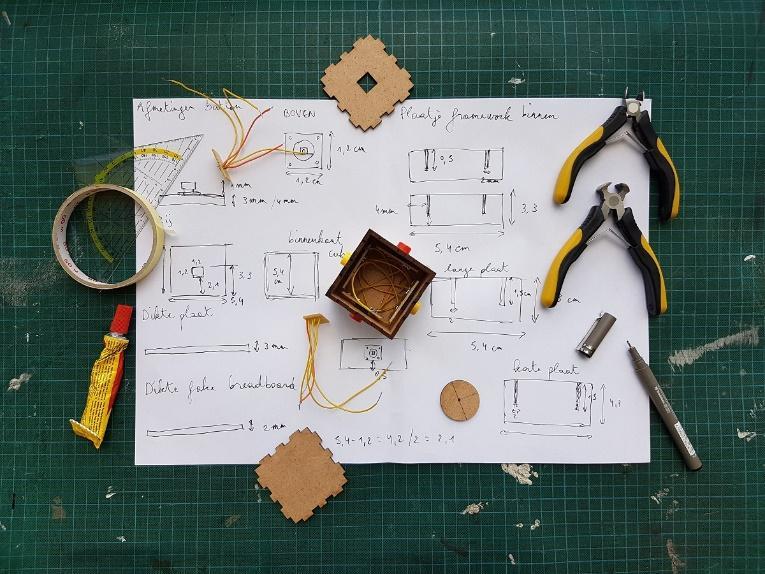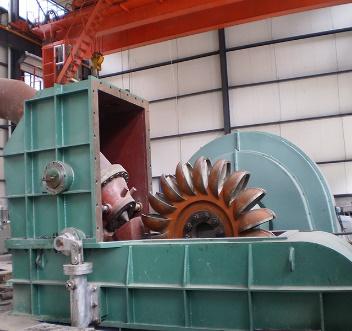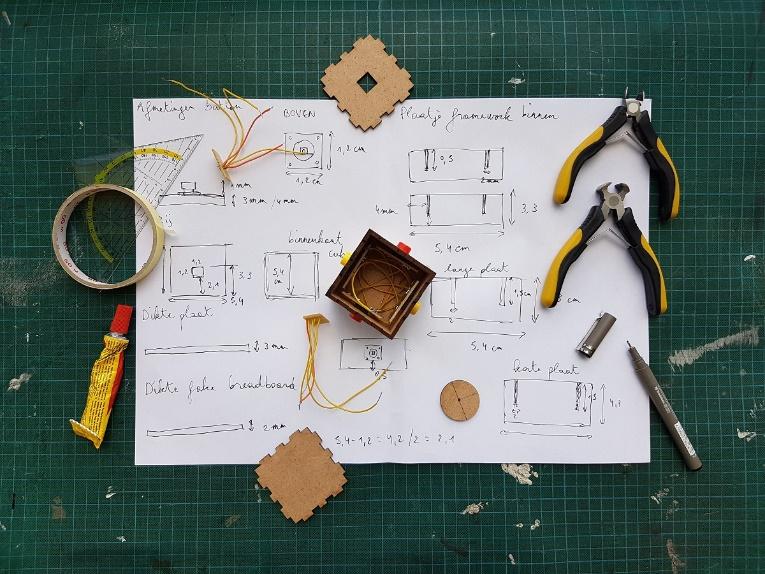Operational Excellence
A Design Story - Design Simplified
 Hi folks, I’m Walter Wardrop, an Operations Management Coach at the Growth Roundtable.
Hi folks, I’m Walter Wardrop, an Operations Management Coach at the Growth Roundtable.
While working with clients to help them improve their productivity flow, I frequent point out opportunities in the design of their product. It always amazes me, how my engineering colleagues can create such a complex item, and then convince the consumer that they need such a complex item. Did the customer ever really ask for an item with 323 fasteners, made of four different metals, in 17 different lengths, and two or three different screw slots.
The fact is customers show far more interest in the object functioning, and only needing a fastener when replacing a consumable part of the item. Time after time, when I tour a manufacturing plant, I am astounded to see the racks of fasteners in all their different sizes and shapes and screw head formats. It reminds me of that old joke where the platypus is a mammal that was designed by a committee.
One of the first tools I teach clients is one I borrowed from Munroe and Associates over a decade ago. Munroe and Associates uses two rules of design, period. The first question asked, “Does the part have to move?” Then ask a second question, “Does the part have to be made from a fundamentally different material?” If you answer no to both these questions, eliminate the part but keep the function of the part. I have used this for my clients, time after time, and had some very impressive results from this. One example from Munroe was that of the accelerator pedal in a car. The pedal is an arm about 3 feet long, going from the where the foot was, through the firewall, and up to the engine control. The part was assembled from 17 different pieces, in five or six different materials, supplied by six or seven different companies. When they got to the automotive company, there were always those quality problems of the bolt being too big or the hole too small.
Using the two rules above, they concluded that instead of doing an $80 assembly, they could just injection mold a plastic part. The new part cost $4 and the quality problems were gone. I have used this concept with many of my clients, taking their item from literally dozens of parts, down to just two or three. Many companies try to take their BOM (Bill materials) and shrink it over time. My direction is far simpler, start with zero parts and justify adding each part to the mix. If there is no justification for adding the part, then do not. At the same time, I will ask the client to figure out how light they can make the item. There are times we look for some heft with a product and relate value to the weight. An example might be a hammer with the mass of that head being important. At the same time, having a hammer handle weighing 3 pounds would not make much sense. We want the mass out at the end of a hammer, where the swing of the arc gives the maximum force.
So, more stories using the two rules. One of my favourites is the work of Ray Anderson, the former CEO at Interface Carpets, from his excellent book Mid-Course Correction. Years ago, he had a bit of an epiphany, and started questioning where all his carpet was going to in the shrinking footprint of this world. He found out that people were sending millions of pounds of carpeting to the dump every week. He asked his staff why it was going to the dump, rather being recycled. They told him that the material could not be separated, as it was what the environmentalists called a “monster hybrid”. It had many different components that could not be separated in the recycling system.
Well, Ray Anderson said then let us make a carpet that is recyclable. We will make a carpet from a single material. His scientist came back to him and said that was not possible, as there were so many different functions they needed from the carpet. My twist on this is that Ray Anderson then pointed out to them. Which part of the words boss and paycheck do you not understand? So, they soon came back with a carpet made from a single material, polyester. The depth, and feel of a good carpet, while also having the durability. This raised the next question, what do we do about the variations in dye lots as we make these carpets. The solution they came up with was to use Fractal patterns on the carpeting. This is a pattern that hides in the variation in color within the carpeting. Another problem was the question of why people change the entire carpet in a room, when only part of it is worn.
This generated the concept of doing floors with carpet tiles. If the tiles in the doorway were worn out, then just replace the tiles in the doorway. There is no need to replace the tiles under the table, as they have only seen two or three footprints in their entire life cycle in that office. They use carpet tiles with their fractal patterns and ability to hide the differences.
The last idea that Ray Anderson and his team came up with was to lease the carpet. We in North America like to buy our carpets. Truth be told, we like to buy just about everything we have. Something about wanting to own stuff. But imagine, you just finished building a 10-story building, and you need to put some carpeting down before you can start moving tenants into that building. Usually you are over budget on your construction costs, and you do not have a lot of money left over to buy the carpeting. Frequently, with these budget restrictions, you’ll buy an inexpensive piece of carpeting, and then argue with accounting, and the government tax collectors over how fast you can depreciate the carpeting, and then replace it with good carpeting later. Enter the lease agreement, wherein you do not have to pay to buy the carpeting, and you can order an expensive carpet for your new building. That is not a problem for you with the lease, for when the bill for the first month of lease of the carpet comes in, it is also matched by the payment from the tenant for occupying that suite for the month. Both items go to the bottom line, so the builder is are not actually paying for the carpet.
With this type of thinking, Ray Anderson’s company, Interface Carpets, went from being eighth to being third in the world. Why do we in North America continue to insist on buying the cheapest item, and completely forgetting about the lifecycle cost of what we are doing. It is stupid of us to forget that one of the most major expenses for purchased items is the rate of depreciation. I have come across this with house construction, where contractors build a cheap house and sell it to a customer, who then maintains it for 30 or 40 years. At the end of that period, the value of the house has frequently shrunk to zero. If there is any value left in the property, it is in the land, not in the house. On the other hand, you see the Europeans building houses of stone and brick, which they mean to last for hundreds of years, and which will show little or no depreciation over that time.
If you are a company, who are going to use energy, labour, and materials to build something, build something to last. There is a story of a local city that was finally big enough to receive their own Walmart. After the Walmart went in the city dump noticed a 30% increase in garbage going to the dump. Prior to the arrival of Walmart, the people in the town bought things that would last and would be handed on to the children. After the Walmart arrived, people started buying the cheap and disposable, with no care for recycling.
A Design Story – Design the MVP Right Now
 Hi folks, I’m Walter Wardrop, an Operations Management Coach at the Growth Roundtable.
Hi folks, I’m Walter Wardrop, an Operations Management Coach at the Growth Roundtable.
I was working with a company that was designing a water turbine for use in fast-flowing waterways. The company was proposing a project to build several new prototypes to test their blade and generator design. They talked about taking 6 months to build the pontoon boat/raft to support the turbine design. I am a sailor, and something about this time frame bothered me. I went home that night and designed a whole new method of supporting the turbine and generator in the water, along with a method for installing and servicing the units. The key to the design was that it would use off the shelf boats, that could be modified in days, to support the generators. It would likely take longer to CAD the drawings than do the actual fabrication.
A minimum viable product is a product that you can make right now. It will likely not pass the certification, but it will give you, the engineers, the marketers, and the investors some idea of whether it is a good concept.
A Design Story - Medical Device
 Hi folks, I’m Walter Wardrop, an Operations Management Coach at the Growth Roundtable.
Hi folks, I’m Walter Wardrop, an Operations Management Coach at the Growth Roundtable.
Years ago, I was invited to visit a company which made a medical device for use in emergency or paramedical situations. The device was designed to help the paramedics supply fluids or other necessary materials to injured people. In some situations, this might have been a military medic helping a soldier that had been shot. The device was a bit of a last resort when the other methods which had been attempted had been unsuccessful.
I watched the client demonstrating how the device would be used, and I proceeded to offer some suggestions revolving around the issues I saw with its actual implementation. The first point I raised was that by the time the device was used, the patient was already in pretty bad straits, and so they cannot afford to wait too much longer before they received the life-saving fluids. The issue I had was that it took the better part of a minute, using two hands, to open all the packaging and get the parts of the device set up to used on the patient. I had a lot of trouble with this, as in most situations involving paramedics and military personnel, it is not a calm and comfortable facility as it was in the boardroom where we were sitting. I also made the point that in the case of the military, it is usually necessary for an individual to keep one hand free, to keep firing his rifle at the opposition. Their device needed one-handed use, and it had to be set up quickly.
As several people sitting around the table were experienced medical professionals, my comments were looked on with a fair degree of disdain. However, when I saw the new design of the device several years later, I was happy to note that it could be ripped open for use with one hand, applied within a few seconds, and had far fewer parts. Those parts that had survived the design simplification were now integrated into a simple final assembly. Sometimes my job involves putting the ideas out there, and letting the professionals stew on the ideas and ask themselves the question “What would Walter say about this part?”
A Design Story – The 50 MHz Computer
 Hi folks, I’m Walter Wardrop, an Operations Management Coach at the Growth Roundtable.
Hi folks, I’m Walter Wardrop, an Operations Management Coach at the Growth Roundtable.
Years ago, I remember reading a story about a major computer company in the early days of microcomputers. They were selling the refrigerator sized computers with a 50 MHz model and 100 MHz model. Companies could not afford the high price point of a 100-megahertz machine, so they ordered the 50 MHz machine. Many of these companies eventually got to the point where they needed the faster 100 MHz machine, so they ordered the upgrade kit from the computer company. After the order was placed, the technician would show up with several boxes and cartons full of boards and circuitry in electrostatic packaging. The technician spent the day working away on the machine, and part way through the day would stop and have a look around to see just who was watching. If the technician is alone, and things were quiet, the technician would reach into the cabinet and pull a diode off the side of one of the circuit boards, buried deep in the machine.
As you might guess from this, the technician was just pulling out the speed limiter. The diode was stopping the computer from being a 100 MHz machine. Every computer that the computer company shipped was a 100 MHz machine, though some of them had the limiter, which slowed the speed of the computer down to 50 MHz. The computer company was saving themselves a lot of money by being able to offer two different models, with two different price points, but they were virtually identical. The difference in price point between the two machines did not justify the company undergoing the trouble of carrying two different lines of machines. Better to make one machine, and sell with two different labels, and keep their customers happy.
This modularity has come up in many industries, where companies are frequently going to great lengths to differentiate their products, while the customers only see the label and a few switches on the front of the box. What the company puts inside the box is usually immaterial to the customer, as the only thing that matters to them is what they see on the front of the box. If you take the time to look under the hood of your car, you will see all kinds of wiring harnesses, many of which are not actually hooked up. They allow the car manufacturer to order a single wiring harness, and then add the appropriate options to the car, either now, or down the road as the car is being serviced, without having to replace or change entire wiring harnesses. The fittings are already in place and are just waiting for the various options to be added.
A Design Story – Tennis Ball Vacuum
 Hi folks, I’m Walter Wardrop, an Operations Management Coach at the Growth Roundtable.
Hi folks, I’m Walter Wardrop, an Operations Management Coach at the Growth Roundtable.
Many years ago, I was called on to help a company that had an issue with the product they had designed. The company had come up with an item that was meant to go on top of the plastic container that usually holds three tennis balls. The concept was to put the balls back in the tube/can, then seal and evacuate the air from the can. This would help to store the balls in a better condition, and result in the balls lasting longer before they lost their bounce. The inventor designed a device that would fit over the top of the can and seal the can. A simple hand motion then squeezed the air out of the tube, creating a partial vacuum.
The inventor was having a lot of trouble getting the parts of the lid to fit cleanly together so as not to allow air to leak out of the device. These six or seven parts, made from two or three different polymers, were fit together in a simple but time-consuming procedure. The result of any one of those parts, being mildly out of tolerance, was that the lid did not pump, or did not hold a seal.
I looked at the product and the parts for a few minutes and then suggested that the inventor might want to change to what was basically a one-piece item, period. The item I was thinking about was shaped like a dog’s hollow chew toy. It would be molded like a bone, and one end pushed inside the other after molding. There would be a simple flap inside it. This unit would be pressed over the top of a tennis ball tube. You then press on the top of the device, which would act as a pump, sucking the air out of the tube. As you released each cycle of the pump, the flap would fall back into place and would hold the vacuum inside the tube. With proper design work, most of the assembly was basically being done in the injection or blow molding machine. Labor was only necessary for the slight alignment of the flap that went into the unit. It would probably take longer to put the item into the box and close it up for shipping than it would do the actual work of assembling the device.
Keep it simple, reduce the number of materials, and the many things that are assembled. It always amazes me how many parts are involved in the assembly of a manufactured device. This device is often then used to do something simple.
A Design Story – What’s Stopping Us from Doing It Right Now?
 Hi folks, I’m Walter Wardrop, an Operations Management Coach at the Growth Roundtable.
Hi folks, I’m Walter Wardrop, an Operations Management Coach at the Growth Roundtable.
Frequently when I am working with companies, they talk about setting up a prototype or new process over the next few months, or even years. I often challenge them with why can't they have it done by next week? And then I go on to prove to them that quite often they can get it done in a very short time. Obviously, we are not talking about long-term clinical tests of medical drugs, or other tests that take years. We were talking about making a prototype widget and trying it out in the very short term. This has recently been given an actual title by those promoting Business Model Generation (Canvas). It is called a Minimum Viable Product (MVP).
A story I frequently refer to is what I heard associated with Lee Iacocca many years ago. For those who are not aware, he ended his career as the head of Chrysler, but had worked for many years with the Ford Motor company. Mr. Iacocca is generally credited with having invented the Ford Mustang, a rather classic car as it was one of the first small convertibles back in the 60s.
Years later, he moved over to Chrysler and was looking at developing some new lines, and basically shaking some of the dust and cobwebs out of the company. At the time, Chrysler had a new car model called the LeBaron. Lee was out on the lot, with a bunch of engineers, looking at a LeBaron and idly mused on whether they could make a LeBaron convertible. He pointed out to the engineers that he had done quite well from the sales of the Mustang convertible and saw no reason why Chrysler could not make a convertible based on the LeBaron chassis.
The engineers went into a short huddle and came back to Mr. Iacocca and said they would have a prototype for him in six months. He looked at the engineers and told them they did not understand what he wanted. Lee told them to go get a chop saw and cut the top off that LeBaron. Lee just wanted to see what the car would look like as a convertible. If he liked it, then he would authorize the work for prototype development.
What are you trying to do, and how fast can you do it? I have seen many high-end products where the first items were made from a roughly carved piece of wood, with duct tape and other bits and pieces wrapped around the unit. Most companies never intend for these first few generations of prototypes to ever get beyond the engineering office, let alone into the hands of the consumer.
How fast can you do it, and why can't you do it even faster than that? Can we be looking at a rough prototype by this time next week?
A Design Story – The Fish Burger
 Hi folks, I’m Walter Wardrop, an Operations Management Coach at the Growth Roundtable.
Hi folks, I’m Walter Wardrop, an Operations Management Coach at the Growth Roundtable.
Our research division was asked to create a microwave fish burger for a major chain. They came up with a good burger that was surprisingly delicious when microwaved. Those that have microwaved bread products will recognize that this is not an easy feat, as the starches tend to become tough and rubbery in a microwave. The key to the design was the special bag the burger was packaged in on the production line. The bag was to be still wrapped around the burger when being microwaved. This kept the steam in place and prevented the bun from becoming hard.
We were all quite pleased with the bun and burger, and proud of what we had accomplished. We put some simple visual cues on the box to demonstrate how the product should be cooked and sent a couple of cases down to our colleagues in Portsmouth to sample. It was our hope that we could also have our American plants producing the same product.
I waited a couple weeks after shipping the burgers, and eventually called to find out what they thought of the product. I was talking to my opposite number, the product development manager in Portsmouth, and asked him what he thought of the excellent new product that we had sent down. There was a pause, and then he politely said that the bun was a little tough and not very good. I was totally surprised, as to be truthful I felt the bun was even better than the fish portion we had created. I asked him what it was like when he opened the microwave, and whether the bagged burger had fallen to the side of the microwave. He responded that when he grabbed the burger, he could feel it was tough. I thought about this for just a moment, and I asked him if he had taken the burger out of the bag before putting it in the microwave on top of the carton. He responded that of course he had opened the container and the bag and placed the bare burger and bun on the carton before microwaving. At this point we realized we had a major problem. If our graphics on the carton were not sufficient to train an extremely experienced technician, what would they do for the public buying the product. We made a new set of graphics that was far more obvious to the consumer, showing that the burger needed to stay in the bag during the microwave step. These days the graphics are far more obvious for such things as microwave popcorn and other products, but at the time microwave reheating was still novel.
This is a major lesson in design of what you should be trying to do, and how you should be trying to communicate with your customers. Frequently the worst person to do the design graphics is the product engineer creating the item. They are so experienced in the product development that they can no longer see it through the eyes of the consumer. Fortunately, we had caught this one prior to going to the marketplace, and we were still able to adjust the instructions on the box. The product eventually became a reasonable bestseller. I still wonder how many people try cooking the item without leaving the burger shrouded by the bag. Does the homeowner accept the tough consistency as a cost of the convenience of the microwave?
A Design Story – The Chilled Seafood Plant
 Hi folks, I’m Walter Wardrop, an Operations Management Coach at the Growth Roundtable.
Hi folks, I’m Walter Wardrop, an Operations Management Coach at the Growth Roundtable.
Historically the issue with selling fresh fish, once it has been filleted, has been the shelf life that the seafood can be maintained for. I am always amazed at how fast seafood can spoil if it is not kept at the proper temperature during the truck transport from the plant to the national markets. My company had the seafood quota to support the construction of a new seafood processing plant and decided to study if it was possible to use the plant design to improve this shelf life. Our research division had done some observations and studies and came up with the concept that we could radically increase the shelf life of our fresh fillets by refrigerating the filleting and processing room in the seafood plant.
The first reaction of most people that heard this was that the poor operators were going to freeze to death, as it would be like working in the Arctic. But here the engineering staff stepped in for the design of the HVAC system within the plant. They made sure that the plant was cold, but also that the air was not circulating over the operators. The fish processing operators wore extra clothing, but engineering made sure that they were not uncomfortable. This is the equivalent of standing outside on a very cold day, without the wind blowing. Without the wind chill, you physically cannot tell just how cold it is outside, because of the laminar layer of warm air surrounding your body. If the wind can draw the warm air away, then you will feel cold. Think of people spring skiing wearing shorts and T-shirts, enjoying the weather, while the wind is not blowing.
When the plant was built and operating, the company was pleasantly surprised to find out how well the shelf life of the fish was extended. If you used to have 20 days before, now it was 30 days to get the same condition. One of the key aspects of the plant design was that the air circulation and distribution took place inside large socks, rather than the regular blowing fans. I have since seen these large socks in a variety of facilities, and even inside stores where there is air conditioning, but you do not want the people feeling cold.
A subset of the chilled plant was the handling of the fish. Historically the fish had been iced in the hold of a vessel, and then shoveled out into large square pallet size totes. These totes carried the fish to the processing line where it was graded and then fed to the appropriate size filleting machine. The issue here was that frequently the fish were away from the ice that they had spent the last two days packed in and were warming up every time they left the ice.
This system was replaced by the European fish boxes, where the fish were caught and iced into the box and stayed in that ice until they reached the filleting machine. Once again we found that this extended the shelf life of the fresh fillets by several days, as well as resulting in a much higher grade of fish fillets as they not had nearly as much manhandling or opportunity to be bruised. Although there was an additional cost in repairing the fish boxes, as they are abused frequently along the way, this was more than balanced by the cost savings and improved quality of fish to the customer.
A Design Story – The CO2 Valve
 Hi folks, I’m Walter Wardrop, an Operations Management Coach at the Growth Roundtable.
Hi folks, I’m Walter Wardrop, an Operations Management Coach at the Growth Roundtable.
Back in the 90s, we tried to speed up the flavor change process on a bottling line. I noticed an interesting aberration in the amount of time it took to flood the carbo cooler with CO2 after the changeover. We found it was taking an abnormally long time to raise the pressure within the carbo cooler.
As I had a full tank of liquid CO2 outside, and I saw there was a 3-inch line coming from it, I could not understand why it was taking so long to pressurize the tank. I went outside and followed the pipe into the building along the walls, and into the room and realized that by the time the CO2 pipe reached the room it was still relatively the same size as when it left the external tank. I then took a longer look at the pipe leading from the ceiling down to the side of the carbo cooler and realized that by the time it had reached the carbo cooler, it had been downsized five times, to the point where there was only a three-quarter-inch line going into the carbo cooler. The interesting fact was that whoever had ordered the cooler tank, in the beginning, had basically put the wrong size input port onto the tank. The manufacturer probably designed the cooler to take an inexpensive valve as a saving, rather than going with the more expensive larger valve. From a cost-effective point of view, the larger valve would have paid for itself within one or two days of operation of the device. To upgrade the tank, it would have cost many tens of thousands of dollars to take the time to cut the tank open, add the new valve, and resurface the inside and outside of the tank in that area. This was not going to happen.
This is a common example of where the design engineer, working within their silo, has attempted to save the company money. What they have not looked at is how to optimize their design to serve their customer better.
A Design Story – The Importance of Simulation
 Hi folks, I’m Walter Wardrop, an Operations Management Coach at the Growth Roundtable.
Hi folks, I’m Walter Wardrop, an Operations Management Coach at the Growth Roundtable.
While working at a seafood plant, I had the opportunity to work with student engineers doing co-op project towards their university degrees. The first project we did was to use simulation to track the movement of the fish boxes in the wet fish processing area of the plant. This had always been an issue for us, as we always seemed to have too many boxes, but never enough for the operators who were doing the processing. Then there was the question of how fast you had to get the boxes sanitized and back onto the line. Also, we would tie up many of the boxes keeping fish stored in the coolers for a few hours between different processing runs inside the plant.
All in all it was a very complicated question, with far more opinions than answers as to how it might be addressed. The students came along with the simulation software product, which was fairly new at the time, and set up a plant simulation for us. It was quite fascinating watching the little figures move around the screen. During the simulation run, the students showed us how at about 1115 in the morning the process line ran out of boxes because of this, that and the other thing. It was a fascinating situation where computer simulation could tell us the prompts, pointing out where the weaknesses were in advance, and give us some opportunity on how to address them or move personnel around in relation to the problems.
Their simulation and their analysis study was so good, that when I had another problem with the design of the fish portion packaging line, I again approached the current engineering co-op students to work up a potential solution. A 2 person student team came to the plant, and analyzed what we were doing in the way of ergonomics on the line. We wanted to get more cartons flowing through line, while we also wanted the operators to be more comfortable in what they were doing. This had long been a problem with seafood plants. Over the years we had designed and built a variety of metal monstrosities, most of which were sitting up on the hill rusting in the sunshine awaiting someone with the time to get them recycled.
The students approached the problem from an entirely different direction. They went after the bioengineering of what the operators were actually doing when packing the portions in the cartons. One of the students had a girlfriend who had worked in a seafood plant. They arranged for the lady to have a line of smalls sensors attached with tape down her back, along the spinal line. The sensors were standard units used for monitoring electrical activity. The sensors tracked electrical signals that were taking place as the muscles worked for the operator packing the seafood. The sensors were hooked up to computer software, and they were quickly able to analyze three or four standard packing table designs. The students came up with the best option that would use the least amount of muscle movement, and the least amount of energy for the operator based on the packing movements.
This student project gave us our standard packing table designs for the next few years. Additionally, the student project was entered in a national contest among engineering universities, and as I remember they finished second in Canada that particular year. This was an excellent integration of engineering study with manufacturing demand. To optimize and improve the operator jobs, I continuously look to the local universities and colleges for student co-op projects to assist my clients in solving their manufacturing pains. Pun intended.
